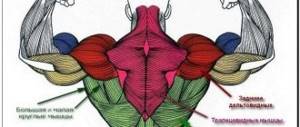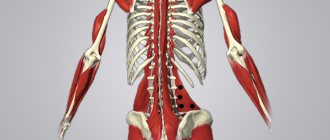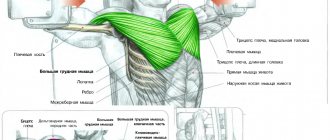The aesthetic purpose of the broad back muscles is to give the torso a cone-shaped shape, the man becomes courageous, and the woman becomes graceful.
How to pump up the broad back muscles? The answer to this question is very simple, start training in the gym under the guidance of an experienced trainer or at home using articles in magazines or video training courses.
So, let's talk about everything in more detail.
Let's develop our back by playing sports at home!
How to pump up a wide back at home? The easiest way is to pump up a wide back on the horizontal bar.
Pull-ups immediately come to mind. Execution technique - grip with palms wider than average, in the final phase until the bar touches the upper chest.
At first, until the muscles are stronger, you can do pull-ups without weights. The number of repetitions is twelve for three approaches.
When strength increases, it is necessary to use any weight, securely attaching it to the body.
Another option, hang on the bar, wide grip. Pull yourself up until you touch the bar behind your head to the base of your neck.
The third variation is to grab the horizontal bar on both sides and squeeze your hands into the “hook”.
We fix our arms and begin to pull ourselves up, using our arms as levers; the main work falls on the latissimus dorsi and rhomboid muscles.
As you inhale, we pull your entire body up, touching the lower part of your chest with your wrists to the bar. Hold for a second and, as you exhale, lower to the starting position.
This type of exercise gives a powerful impetus to the development of most of the back muscles, and also includes the pectorals, triceps, deltoids and forearms.
Back exercises in the gym
| Pull-ups . If you want to get a wide back, pull-ups cannot be avoided. This exercise does a great job of widening the latissimus dorsi muscles, known as the “wings,” without thickening them like the bent over row. It is most productive to pull yourself up with a wide, straight grip to your chest, using weights to engage the greatest number of back muscles. |
| The deadlift is often considered a basic exercise, although it only puts stress on the extensors – the longus muscle. This exercise does not affect the width of the back, it makes it thicker. Also, the exercise has a negative effect on the waist, expanding it, so it is not suitable for everyone. |
| Bent-over barbell rows are one of the main exercises for building back width. It has several options. The traditional version uses a straight grip and bends the torso parallel to the floor. |
| The dumbbell row is an exercise for the latissimus muscles that works all segments of the muscle being trained in isolation. The dumbbell row allows you to expand your upper back and improve your strength. |
| The T-bar row develops the middle segment of the latissimus muscles. The exercise is distinguished by the fact that the bar is fixed on one side, fixing the amplitude of the movement, due to which failure repetitions are performed - “refinement” in a compressed amplitude, stimulating the growth of muscle fibers and developing the athlete’s strength indicators. |
| The lat pull-down is an isolation exercise that simulates a wide-grip pull-up. There are two reasons for doing this. It is also available for those who have not yet learned how to do pull-ups, and after performing pull-ups, this exercise well deepens stress in the target muscle groups. |
| The lat pull-down is also an isolation exercise that can be done instead of barbell rows, but it is often used in addition to deadlifts. The undoubted advantage of this exercise is to ensure high-quality stretching of the muscles, which allows them to hypertrophy. |
| Hyperextension is an effective exercise for working the lower back. It is recommended not only for those who want to look beautiful, but also for those who care about their health. Hyperextension has a significant difference from other exercises for the back: you should inhale when making an effort, and exhale during the negative phase. |
Read also: How to learn to do pull-ups on a horizontal bar?
Stabilizer - an easy and cheap way to develop back muscles
Buy a stabilizer at any sports store - this will allow you to pump up your wide back at home inexpensively and practically.
This simple, mobile simulator is very convenient: you can easily take it with you on business trips or travel, and adapt it to any situation.
The stabilizer is a durable rubber rope with a thickness of 6 mm and a length of two and a half to five meters.
The resistance of the stabilizer does not occur immediately, but slowly as it stretches, depending on the length.
An increase in strength during exercise is achieved by winding the rope several times.
Is it possible to achieve such results at home?
Training at home is definitely effective , which has been proven by many examples. Of course, it cannot be said that there is no difference between intense home workouts and training in the gym. However, achieving visible results by training at home is an entirely achievable goal.
Why do gym sessions give more significant results? The fact is that progression and growth are determined by increasing the load on a muscle group, and this requires a regular increase in working weight. It is almost impossible to ensure that you have different types of free weights available at home that you can use for exercise. It should be noted that only experienced athletes who have been training for at least two years can constantly train with heavy weights. But at the start, in order to pump up your back and achieve a beautiful silhouette, training at home is quite enough.
Examples of exercises with a stabilizer
Stand at the very center of the stabilizer, take the ends of the tourniquet in your freely lowered hands. We raise our outstretched arms up and down. After a short rest, being in the same position, standing we raise our arms in different directions.
We sit on the floor and securely attach the stabilizer to the radiator or door frame. We tilt our body back a little and pull our hands towards our stomach.
We place a chair or bench on the stabilizer, take the free ends in our hands over our shoulders and bend our torso until it touches the lower part of our thighs.
In all exercises, the number of repetitions is 20 for 4-5 approaches. The length is adjusted by winding the excess around the knuckles.
Another easy to do exercise. Lie on the floor with your stomach down, fix your feet under the bed or sofa.
Lift your body up, bending your lower back to the very limit, stay at the top point for a few seconds and come back.
Another interesting exercise that does not require any equipment from you is push-ups. We place our hands wider than our shoulders, our lower back is straight, and slowly lower ourselves to the floor until we touch our chest.
This exercise uses the muscles of the chest, shoulders, and back. 15-20 repetitions, 4 sets.
As your strength increases, you can increase the load. Ask your loved ones to sit on your back or put their hands on your upper back for resistance. The benefits will be multiple.
If you have dumbbells and a barbell at home, the range of your exercises will expand dramatically.
Now the answer to the question is it possible to pump up the broad back muscles with push-ups.
We train with weights
How to pump up a wide back with dumbbells? Using weights in the form of dumbbells when working on the back muscles will make it more prominent
One of the most effective is the dumbbell abdominal press. The number of repetitions is 8-10 in 3 approaches.
With one hand and the same side of the knee resting on a horizontal bench, we rest our other foot on the floor, keeping our head straight.
With the other hand we take the dumbbell and with a powerful force we pull it towards the belt. You need to try to raise your elbow to shoulder level and slowly lower it back.
Remember, we do this exercise only with the strength of the latissimus dorsi muscles, the arms are like a faucet, the body is clearly fixed.
If you have back problems, then this can be done in another variation. Place a bench, lie on your stomach on it, arms at your sides, take dumbbells, press your elbows to your body and lift the dumbbells up to the very limit.
Shrugs with dumbbells. This is a great exercise for pumping up the trapezius. Take dumbbells, stand up, straighten your back. Shoulder lift, arms straight: up and down. Number of repetitions: 8 in 3 sets.
How to quickly pump up your back
- Remember that intensive training of the pectoral muscles leads to the fact that the shoulders are pulled forward, which visually makes the back narrower . In addition, we spend most of the day sitting at a desk, which also does not help improve posture.
- When training their back, many people try to lift as much weight as possible, switching work from the back muscles to the muscles of the shoulders, arms and torso. Remember that first you must learn to feel the muscles of your back, and only then increase the weight .
- In order to “feel” your correct posture, stand up straight, inhale more air, push your chest forward, straighten your shoulders, move them a little back and up, keep your head straight and tense your abdominal muscles.
- While walking, try to take a position with correct posture, watch this, fix and correct yourself - time will pass, and such posture will become natural. When sitting, place both feet on the floor and try not to touch your entire back to the back of the chair.
The barbell is the best assistant
How to pump up broad shoulders and back? After dumbbells, we begin to use a barbell in training. We focus on developing strength and mass in the back.
Buy or borrow from friends a barbell with plates and clamps, weighing up to 100 kg.
Before training, an intensive warm-up is required: rotating the body in different directions, stretching the arms and legs, flexing and extending the spine.
We perform the first repetitions with light weight, it prepares the muscles for intense work. The main exercises here are: deadlift, bent-over barbell row.
The option of working with a barbell will solve the question of how to build a wide back for an ectomorph, as this simplifies his work.
How to pump up your back muscles
To understand how to pump up your back correctly, you should study basic information about how the muscles that form this group are structured. Traditionally, they are divided into three subgroups: trapezius and latissimus muscles, as well as back extensors.
Trapezius muscles (shrugs)
These are the upper back muscles, shaped like a trapezoid, covering most of the back of the neck and back. The trapezoid starts from the back of the head and reaches the shoulder blades and collarbones. The fibers of this muscle are responsible for its stretching up, down and inward. The functions of the trapezius muscle include rotating the head and lifting the shoulders.
Many athletes work this muscle in conjunction with the shoulders, which is a good option.
Latissimus muscles (pull-ups, bent-over barbell rows)
These are the largest muscles of the back. When they are well worked out, the back gains strength. The latissimus muscles are attached to the upper edge of the humerus, from where they descend down along the spine to the pelvic girdle. They are responsible for pulling the arms down, and, when fixing the arms, help push them up.
Back extensors (deadlifts, hyperextensions)
These muscles provide a straight position for the back so that it does not bend under the weight of projectiles. When planning a lot of squats or deadlifts, you should train your extensors. In addition, they are close to the spine and, creating a muscular corset, prevent displacement of the vertebrae. So everyone needs to work through them.
Comprehensive development of the back muscles requires performing these basic exercises:
- vertical rows, including pull-ups and similar rows using exercise machines;
- horizontal rods perpendicular to the body. For example, horizontal rows using a machine or bent over barbell lifts;
- deadlifts and other lifts for the lower back and lower back muscles.
A typical version of the training program focuses on the back once every seven to ten days. The tasks are combined in this way: exercises to develop the latissimus muscles and upper back are performed first, then the lower part is worked on.
Back training can be done separately or in combination with other muscle groups. Most often, the back is trained together with the biceps. In these circumstances, you should omit one of the back exercises so that the session is not too long and does not exceed the amount of work aimed at gaining mass. You can add one or two exercises for the biceps, but no more, since the biceps are also strained when doing back exercises.
Vertical thrusts must be done alternately with horizontal ones so that similar exercises do not follow one another. So, during the restoration of some muscle fibers, others are trained.
Deadlift
The basis of any strength training, it is very effective, gives volume and thickness to the muscles, but is dangerous.
Stand in front of the barbell so that the bar touches your shins, feet shoulder-width apart, toes pointed out to the sides. The body position is the same as in a squat.
Grasp the barbell with an overhand grip slightly wider than shoulder-width apart. The back is straight, the head is too, the chin is raised.
You need to tilt your body forward slightly until your arms are tense. As you inhale, lift the projectile off the floor, keeping your back straight.
The bar should be as close to your legs as possible. Having overcome the most difficult point of the trajectory, exhale.
The movement ends when a strictly vertical position is reached. Keeping your back straight, lower the barbell to the floor.
Pause, check that your starting position is correct, and continue with the exercise.
Be sure to use shoulder straps and an athletic belt.
In no way do we bend our lower back upward when performing this exercise. This can lead to injury in the form of displaced spinal discs.
If, when working with a barbell, the emphasis is shifted to turning off the legs, then the main load will fall on the rear biceps of the thigh and lower back.
It is better to do the deadlift according to the pyramid principle, with each approach the weight of the projectile is greater: 1 approach - 10 repetitions, 2-8, 3-6, 4-4.
Bent-over barbell row
The bent over row of the barbell gives width to the back, and the deltoids are also included in the work here.
Performance technique. Stand with your feet shoulder-width apart. Arch your lower back. Press your hands to your body, grab the barbell and pull it towards your waist with a smooth movement.
Inhale as you lift the barbell, exhale as you lower it. At the initial stages, you can work without a belt, as soon as the weight of the projectile begins to increase, then be sure to use a safety belt.
At the initial stage, the weight is light, 2-3 sets of 10 repetitions. With an increase in strength, you should exercise according to the pyramid principle: 1-10, 2-8, 3-6. We increase the weight of the bar.
Hyperextension
How to pump up the lower part of the broad back muscles? If for health reasons you cannot use weights, then an alternative exercise would be hyperextension.
Starting position - lying on a horizontal bench face down, feet securely fixed, hands can be behind your head or a cross on your chest.
We inhale and lower ourselves, hold for a second and as we exhale rise up. The number of repetitions is 20-25 in 2-3 approaches.
If performed correctly, the lower back will be thoroughly pumped. If you have gained strength, then you need to use weights in the form of a pancake. We fix it in our hands and bend forward and backward.










